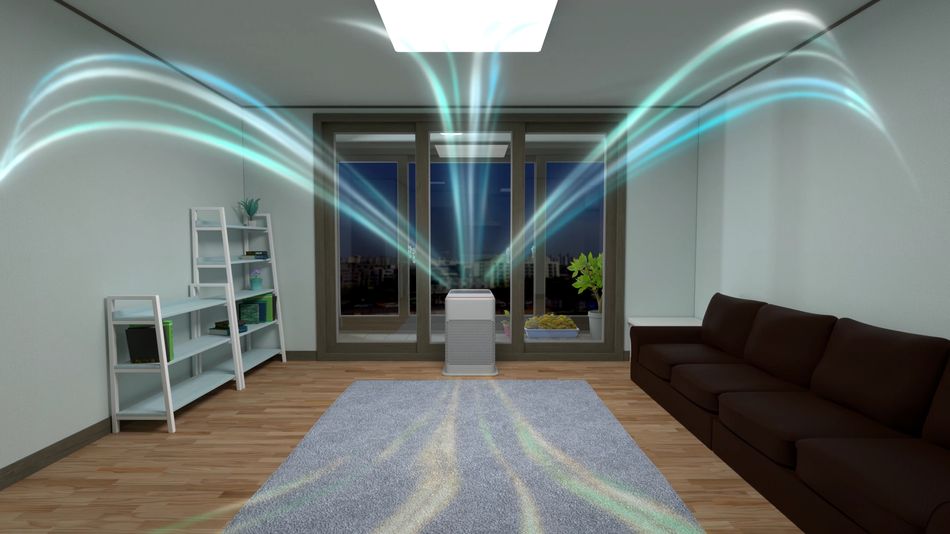Breathing Better: Using Environmental Sensors to Improve Indoor Air Quality
Air Quality Indexes (AQIs) are used to measure the concentration of pollutants like particulate matter and other harmful substances in the air outside.

Sensors to monitor and regulate indoor air quality can have a positive impact on home, work, and school environments. Image Source: EPA
Introduction
The EPA estimates that the average person in the United States spends approximately 90% of their time indoors, where surprisingly the concentration of pollutants can be 2 to 5 times greater than typical outdoor concentrations. [1] Furthermore, traditional signs of poor outdoor air quality such as smoke, or strong odors may not be as noticeable indoors. Air quality monitoring technology is crucial to detect indoor air pollutants that can't be easily perceived. Monitoring and then taking steps to improve air quality can have a significant impact on the occupants of educational institutions, workplaces, and the home.
Poor indoor air quality is associated with health problems like headaches, fatigue, and certain illnesses. While some effects are more short term, long lasting serious health issues such as cancer, heart disease, and cardiovascular disease can result from continuous exposure to harmful airborne particulates. This article delves into the determinants of air quality, its impact on well-being and productivity, and how environmental sensors can be used to improve indoor air quality.
The air we breathe
Though perhaps previously taken more for granted, the Covid-19 pandemic made the world pay close attention to indoor air quality. Due to the possibility of viral transmission via airborne particles, people became acutely aware of air circulation indoors, and many workplaces and schools took new measures to monitor and improve conditions. [2] Now in a post-pandemic era, it is important to continue efforts to monitor and improve indoor air quality.
According to the WHO, household air pollution resulted in over 3 million premature deaths among both children and adults per year. [3] Common indoor pollutants include particulates, gases like CO and CO2, mold, volatile organic compounds (VOCs), and carcinogens. These can be caused by a combination of factors such as inadequate ventilation, the presence of indoor pollutants like tobacco smoke, VOCs from cleaning products and furnishings, mold growth, pet dander, and high levels of carbon dioxide (CO2) due to insufficient fresh air exchange.
Poor air quality has both short and long term health effects. Some people may experience dizziness, headaches, or fatigue due to the use of certain cleaning products, or the lack of ventilation in an indoor space. Other even more serious impacts include respiratory disease, cardiovascular disease, heart disease, and cancer. These can result from the presence of mold, harmful toxic gases, and secondhand smoke.
Furthermore, high CO2 levels indoors can lead to reduced productivity and drowsiness, which has a direct impact in workplaces and schools. [4] Studies show that better ventilation and lower CO2 levels result in more productive and content employees. For example, a 2018 study by the British Council for Offices found that workers demonstrated the ability to work up to 60% faster in environments with lower CO2 concentrations. [5]
What are Environmental Sensors?
Environmental sensors gather real-time information on pollutants, noxious gases, and other detrimental factors impacting air quality, establishing an early warning system that guarantees indoor comfort and has the potential to save lives.
Monitoring indoor air quality involves assessing multiple factors such as carbon dioxide (CO2), particulate matter (PM), volatile organic compounds (VOCs), and temperature and humidity levels.These components collectively influence the overall quality of the air we breathe within enclosed spaces.
Types of sensors for monitoring indoor air quality
Achieving accurate and reliable indoor air quality monitoring relies on the utilization of various sensor technologies that cater to specific pollutants and environmental conditions. These sensors employ diverse detection approaches to measure a wide range of pollutants.
For gas phase pollutants such as ozone (O3), nitrogen dioxide (NO2), carbon monoxide (CO), and volatile organic compounds (VOCs), sensors employ methods like electrochemical cells and gas-sensitive semiconductors. CO2 sensing involves the utilization of various sensor types, including non-dispersive infrared (NDIR) sensors, electrochemical sensors, and metal-oxide-semiconductor (MOS) sensors.
Meanwhile, particulate matter (PM) pollutants are measured using optical particle counters, which individually size and count particles by analyzing light scattering. [6] By converting these detected signals into estimated pollutant concentrations, real-time measurements of air quality are generated, enabling insights into environmental pollutant levels. As particles vary in size, PM sensors must use diverse detection methods, enabling the measurement of coarse particles (PM10), fine particles (PM2.5), and ultrafine particles (PM0.1). For example, the Sensirion SEN5x sensor utilizes a laser-based method that interacts with particles and reflects light to a photodiode, facilitating precise PM measurements. [7]
In parallel, Volatile Organic Compounds (VOC) sensors encompass multiple contaminants, employing a range of detection techniques like photoionization detectors, flame ionization detectors, and MOS sensors. In these instances, calibration is pivotal, as sensors react uniquely to different VOCs.
Beyond the focus on major contaminants, temperature and humidity monitoring plays a crucial role, as they exert significant influence on toxin levels within the air. This integration of various sensor technologies underscores the intricate nature of monitoring efforts, contributing to a comprehensive understanding of the interplay between pollutants and their impacts on human health and wellbeing.
Balancing power and performance
When developing environmental sensors, designers must balance two critical factors: power consumption and performance. Most indoor air-quality monitoring systems comprise dedicated sensors and wireless communication for data transmission to a central hub. These systems are often battery-powered, necessitating a tradeoff between power consumption and performance. Sensors with higher performance may consume more power, leading to faster battery drainage and downtime.
Conversely, lower power consumption might compromise sensor accuracy and communication reliability. Achieving an optimal balance between performance and power consumption is crucial. This involves smart component selection, intelligent use of sleep modes, and choosing suitable wireless communication protocols based on application and deployment location. [8]
Conclusion
With so much of our time spent inside, it is important to monitor and improve indoor air quality, especially in workplaces and schools. Not only does it enhance productivity, better air quality and circulation has positive short and long term effects on our health and wellbeing. As we advance into a post-pandemic era, the integration of environmental sensors into our indoor spaces holds the promise of healthier living, working, and learning environments. These sensors not only empower individuals with real-time insights into their surroundings but also guard against the invisible threats posed by indoor air pollutants.
Building Environmental Sensing Products and Systems
Mouser Electronics is a global distributor of electronic components, serving engineers across various industries. Mouser’s catalogue includes a wide range of environmental sensors. These sensors are designed to monitor various environmental factors such as temperature, humidity, air quality, and pressure. Mouser's platform, "Empowering Innovation," serves as a hub for engineers and tech enthusiasts to explore and learn more about these advanced sensors. Listen to Raymond Yin, Mouser's Director of Technical Content, as he explores the new technologies and promising developments on Environmental Sensors with Ronan Cooney, Head of Product at Ambisense in their latest podcast.
The company collaborates with top manufacturers to offer sensors that are not only highly accurate but also energy-efficient, making them ideal for both industrial and consumer applications. By providing detailed datasheets, customer reviews, and expert advice, Mouser ensures that customers make informed decisions. Their commitment to sustainability is evident in their choice of environmental sensors, which play a crucial role in building smarter, more eco-friendly systems.

Resources
[1] United States Environmental Protection Agency. Air Sensor Technology and Indoor Air Quality. [Internet] [updated 2022 Dec 21; cited 2023 Aug 25]; Available from: https://www.epa.gov/indoor-air-quality-iaq/air-sensor-technology-and-indoor-air-quality
[2] United States Environmental Protection Agency. Indoor Air and Coronavirus (COVID-19). [Internet] [updated 2023 June 7; cited 2023 Aug 25]; Available from: https://www.epa.gov/coronavirus/indoor-air-and-coronavirus-covid-19#:~:text=They%20can%20also%20be%20exposed,entire%20room%20or%20indoor%20space.
[3] World Health Organization. Household air pollution. [Internet] 2022 [cited 2023 Aug 25] Available from: https://www.who.int/news-room/fact-sheets/detail/household-air-pollution-and-health?gclid=CjwKCAjwoqGnBhAcEiwAwK-Okb2vVWCs_fLBuPkxNVt0rYqu78EKPueIRndDZTN0FM4ZeDJ0iPgu-BoC91kQAvD_BwE
[4] Water and Air Quality Bureau, Health Canada. Residental Indoor AIr Quality Guidelines. [Internet] 2020 [cited 2023 Aug 25] Available from: https://www.canada.ca/content/dam/hc-sc/documents/programs/consultation-residential-indoor-air-quality-guidelines-carbon-dioxide/consultation-residential-indoor-air-quality-guidelines-carbon-dioxide.pdf
[5] British Council for Offices. Improving Workplace Productivity. [Internet] 2018 [cited 2023 Aug 25] Available from: https://www.emcoruk.com/workplace_productivity.pdf
[6] United States Environmental Protection Agency. Evaluation of Emerging Air Sensor Performance. [Internet] [updated 2023 June 6; cited 2023 Aug 25] Available from: https://www.epa.gov/air-sensor-toolbox/evaluation-emerging-air-sensor-performance
[7] Alex Pluemer for Mouser Electronics. Sensors for Improving IAQ. [Internet] [cited 2023 Aug 25]. Available from: https://resources.mouser.com/eit-environmental-sensors-articles-en/sensors-for-improving-iaq?_gl=1*f2kik1*_ga*ODIyMzU4NTU0LjE2OTI2OTQxNDk.*_ga_15W4STQT4T*MTY5Mjk2NjMzNy40LjEuMTY5Mjk2NjQ2OC4wLjAuMA..*_ga_1KQLCYKRX3*MTY5Mjk2NjMzOC40LjEuMTY5Mjk2NjQ2OC40MS4wLjA.
[8] Ronan Cooney for Mouser Electronics. Environmental Sensors Use Case: Monitoring Indoor Air Quality. [Internet] [cited 2023 Aug 25]. Available from: https://resources.mouser.com/eit-environmental-sensors-articles-en/environmental-sensors-use-case-monitoring-indoor-air-quality?_gl=1*f2kik1*_ga*ODIyMzU4NTU0LjE2OTI2OTQxNDk.*_ga_15W4STQT4T*MTY5Mjk2NjMzNy40LjEuMTY5Mjk2NjQ2OC4wLjAuMA..*_ga_1KQLCYKRX3*MTY5Mjk2NjMzOC40LjEuMTY5Mjk2NjQ2OC40MS4wLjA.



